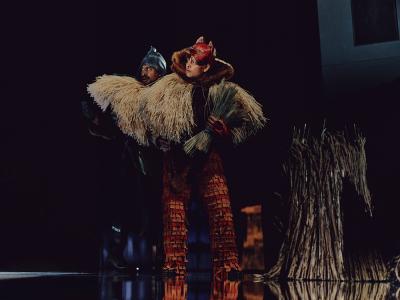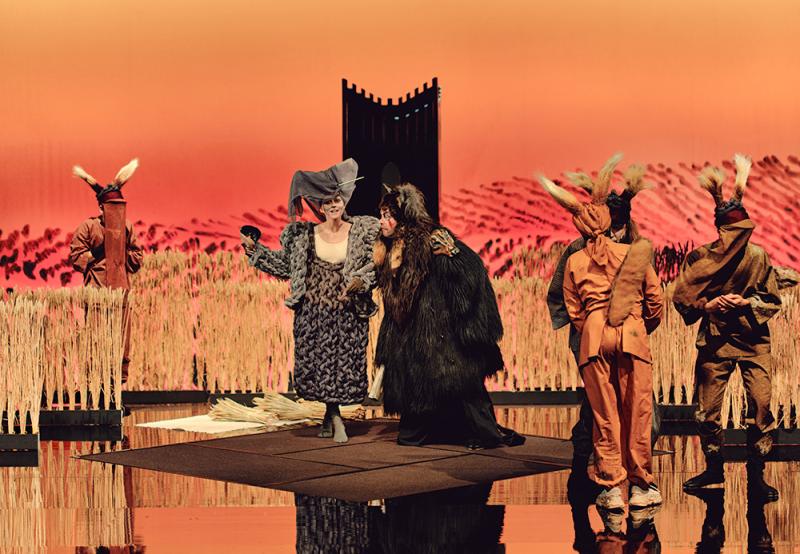Designers generally begin work on operas a year or two before the first rehearsal. Not so Robin Hood, which began previews at Schauspielhaus Zürich on April 9. Costume and production designer Carlos Soto received the script in March, just two weeks earlier.
As production designer, Soto oversaw the overall design. As scenic designer, he collaborated with Nina Mada, a Zurich-based designer who usually works in film. She had worked with the project’s director, Wu Tsang, at the Schauspielhaus. “Her familiarity with the venue has been indispensable,” Soto says.
Soto began to do research in November 2024, sans script. He says he has been, “Hastily refining ideas as the workshops build, which is a fun process, very different from my usual work in opera. Improvising as things come together is somehow a wholly different zone of the brain.”
Moved by the Motion, a collective of Wu Tsang, Tosh Basco, Josh Johnson, and Asma Maroof, collaborated with writer Sophia Al Maria to reinterpret and modernize Robin Hood. “Instead of the individual hero, the story focuses on the power of the collective, friendship and solidarity,” the Schauspielhaus website reports. “The forest becomes a place where alternative ways of life are explored, far from corruption, greed and social coercion. Moved by the Motion asks when theft can be just, and what utopian possibilities lie in a life of connectedness and nature, using powerful imagery to create an experience that combines reflection and fantasy.”
“Wu and Tosh have opted to forego any reference to money or gold and make the story about agriculture, harvest vs hoarding,” says Soto. But how, he wondered, might he approach the work that would take place in a forest with anthropomorphized animal characters, as in the Disney movie: How do we do this without having trees on stage? How do we do this without resembling Disney?
Soto enjoyed the Disney movie as a child, but he wanted to avoid homages or indirect comparisons to it. “I proposed that if we pivot geographically while remaining in the ‘Middle Ages,’ then the theatrical and aesthetic traditions that arose out of that ferment could just as well suit the story,” he says. “Wu Tsang and her partner Tosh Basco are both of mixed Asian backgrounds and love to lean into that heritage while also playing on the ambiguity of cultural blending and appropriation. It was quite helpful to arrive at this decision while the script was still in seed stage.”

Once he had a script in hand, everything moved quickly. After researching for weeks, Soto designed costumes in days, melding “Alpine folk dress and figures from medieval Japanese theatre–Nōh, Kyōgen, Kagura–and Kabuki.” He says he found strange parallels between the two worlds while creating a fantasy world all its own. “The costumes are mostly fabricated, though some elements have been acquired from craftspeople in Japan, and some things sourced here in Switzerland. The makeup department surprised us with a secret weapon---one of the assistants is also a mask-maker.”
Video on the design from Schauspielhaus Zurich.
The scenic design came together quickly, too. “Nina and I made a kind of machine-for-performance, comprising a downstage rake in extreme false perspective, with a pit and trough for Robin's campsite, plugged with reversible tatami mats crafted from sisal, since the carpets are inherently flame retardant.” These are surrounded by faded black Noren curtains, printed with blurry fireflies to demarcate the campsite and leading up to a bridge. “We turned the traditional Hanamichi parallel to the edge of the stage, and behind that a roughly square carpeted platform with two large troughs on either side for appearances and disappearances of performers and scenic elements like fields of wheat. It's been great working with Nina through all of it as we can both maintain a modicum of objectivity while waiting for dribs and drabs of information from the lead creatives.”

Surprisingly, Soto found this lack of information, “incredibly productive. We arrived at a very simple, if monumental, space taking cues from Nōh and Kabuki for our approach to props and stage mechanisms, allowing for a multitude of possibilities with a limited number of modular elements.”
In Wu's agricultural world, the forest folk don’t steal gold but grain. “Furthest upstage is a second Hanamichi for further entrances and exits, and then a layered painted gauze with abstracted motifs representing a stormy sky, grain fields, rain, [and other elements], depending on which direction it's lit from.” Frank Bittermann designed the lights.
A series of sliding panels, modeled after a room in the Imperial Palace in Kyoto, represent the interior of the Sheriff of Nottingham's fortress. “It is both interior and exterior, as the decoration resembles a misty mountain landscape [with the] -railing painted in extreme false perspective. [It] gives the illusion of a far larger enclosed space. A black border downstage of the gauze raises and lowers the horizon line as needed,” says Soto.
“The effect when only the upstage panels are present is of a distant panorama. When the side panels appear, we are inside a room decorated with a distant panorama, so that there is always an ambiguity between interior and exterior. SR and SL are two massive tabs made of high-gloss black acrylic panels, like the downstage rake, which expands the horizon line infinitely, giving the illusion of a much larger stage than we're actually working with,” Soto says.
“The rest of the scenic elements play with my favorite qualities of transparency and reflectivity, painted sliding panels, for example, are a metallic silver cloth from Showtex which can be lit from behind, for example, to create various effects,” he says.” There are also a series of lightning bolts which descend from above, fashioned from steel C-channel and diffused LED "neon" product, which can achieve various effects, like a slow-motion lightning-strike, or, because the LEDs are skinned with fine black cotton gauze, they become a solid object which can double as a dilapidated prison chamber.”
“I think the challenge of working backwards, in a way, brought up an interesting formal approach, which perhaps only makes sense for my way of working,” Soto reflects. He usually starts with an overall structure that suggests the visual and temporal ark of a piece. Because he didn’t have this structure, he considered the different spaces as modular elements that could serve multiple purposes with various visual qualities. These, he says, “could be altered via reconfiguration of discrete elements or through shifts in light.”
In the end, the challenges of the opera had less to do with the timetable than with doing tech in a repertory house. “In some ways, however, working modularly helps to consolidate a lot of things, so that we’ve often inadvertently designed the light for a scene without knowing it because we return to that set-piece and can adjust the lighting vocabulary to shift the scene somewhat. So, even if we’re looking at the same stage image, the eye doesn’t get bored and, consequently, neither do we.”